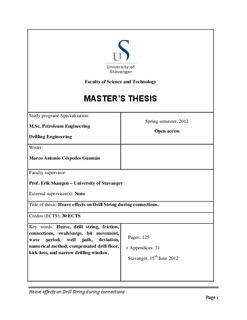| dc.description.abstract | During the make-up and break-out of the connections, the drill string is wedged in the rotary table and the top of the drill string follows the platform heave movement as the bit is off bottom. This oscillation may be transmitted down the string and produce pressure fluctuations around the string, especially at the bottom of the string due to the small clearance between BHA and borehole. This can cause high surge and swab pressures that may lead to undesired loss of circulation or influx of formation fluid.
This thesis presents a numerical method developed at the University of Stavanger (programmed in MatLab), for calculating the behavior of elastic drill strings when exposed to the forced movement at the top (platform heave movement). The method is restricted to treating only one-dimensional waves, travelling along the string axis. It considers all the elastic effects and some of the effects of friction, such as contact friction and viscous friction inside the drill string. The down hole oscillations of the drill string drill bit and the pressure fluctuations below the bit were calculated, assuming that the pressure is generated by forcing the mud to flow up and down the annulus as the bit moves down and up, respectively.
The basic well case consists of a “Build and Hold” directional well, where the well is drilled vertically 500 m to the KOP, where the well is smoothly deflected until a maximum desired deviation. The established deviation is maintained while drilling to the target depth. The drill string has a 5” DP section, a 200 m 8” BHA section, and a 12” drill bit. The wellbore is partly cased, and the mud properties are considered as standard. Several scenarios were simulated in order to evaluate the effects of the drill string length, deviation, wave conditions, amount of numerical segments, etc. upon the pressure fluctuations and bit movement. As expected the pressure fluctuations and bit movement increases when the wave conditions are harsher, more accuracy is obtained when the amount of numerical segments is increased, and longer wells with high deviation damp down the bit movement due to the increased contact friction, thus also the pressure fluctuations.
The results obtained by the method can be regarded as conservative, since the actual pressure fluctuations probably will be less than the ones calculated here. Thus, they still can be used for better planning of drilling operations, and a better understanding of the drill string oscillations, giving an enhanced wellbore pressure profile management, and a strong indication that in very sensitive reservoirs a heave compensated drill floor could be used to drill more efficiently and safely. | no_NO |
